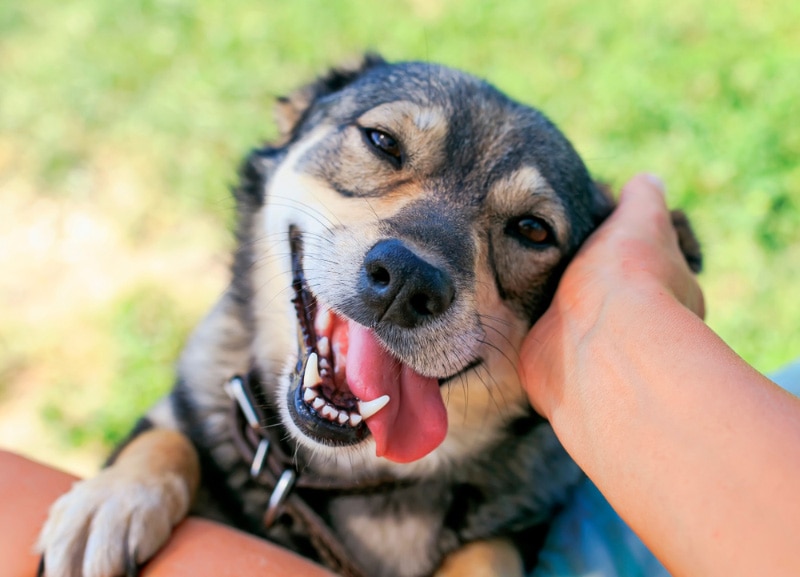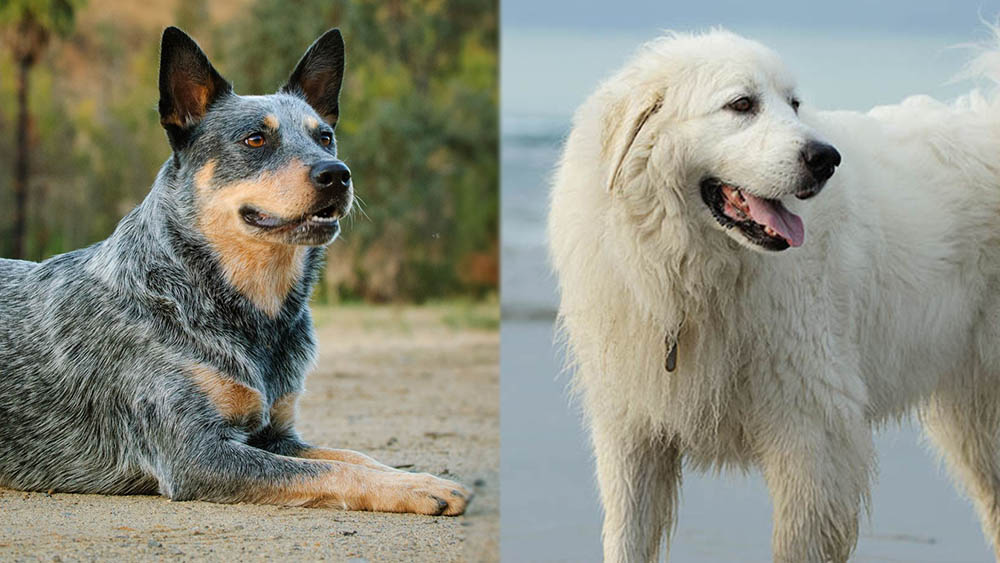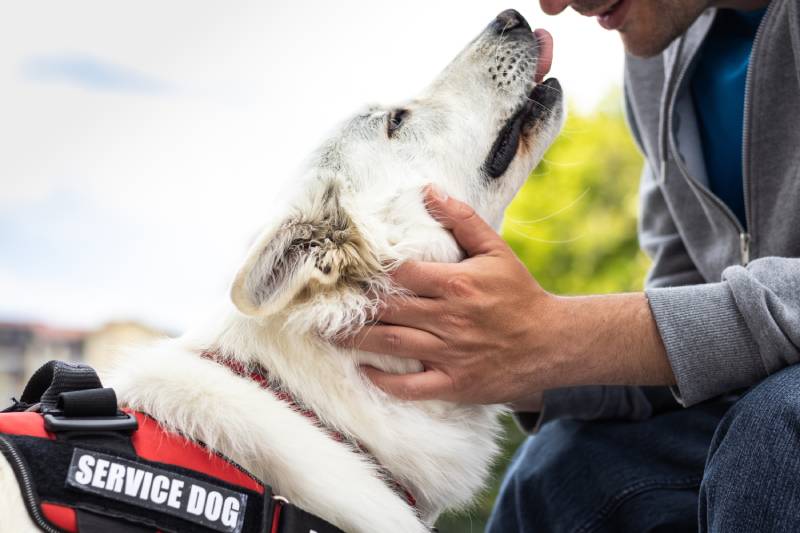Dalmatian vs Great Dane: Main Differences (With Pictures)

Updated on
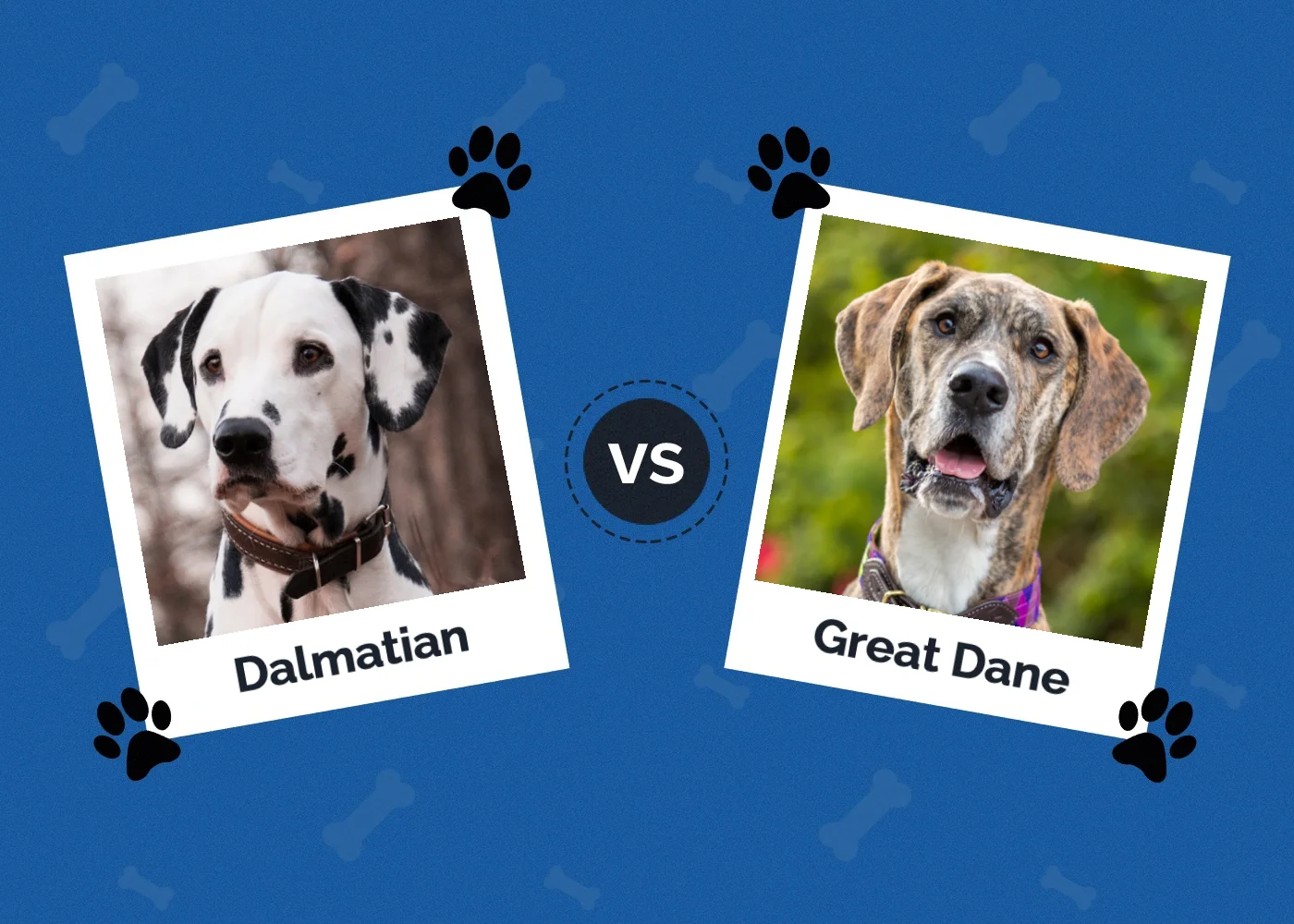
Click to Skip Ahead
Have you ever been curious about the differences between a Dalmatian and a Great Dane? While both breeds are large and majestic, they have many distinct differences. These differences are important to note if you’re considering purchasing one of these dogs for the first time.
From their size and weight to their personality and temperament, this comprehensive guide will explore every aspect of the Dalmatian versus Great Dane debate. So, whether you’re looking for a loyal companion or a guard dog, this guide will help you determine which breed is the best fit for you.
Visual Differences
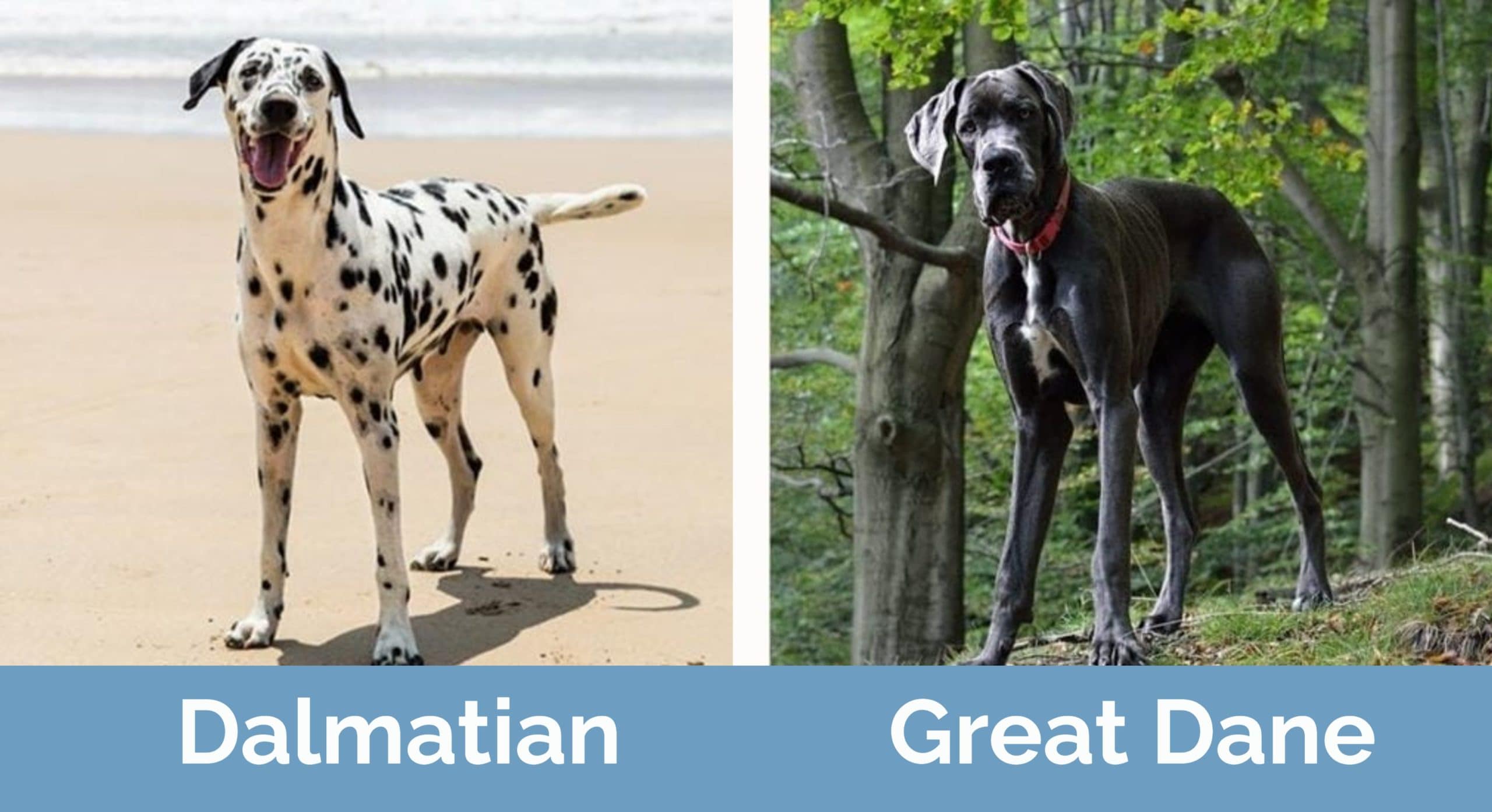
At a Glance
- Average height (adult): 22–24 inches
- Average weight (adult): 35–71 pounds
- Lifespan: 10–13 years
- Exercise: At least 90 minutes a day
- Grooming needs: Medium (every 3–4 weeks)
- Family-friendly: Yes, but may be too energetic for small children
- Other pet-friendly: Yes
- Trainability: Easy
- Average height (adult): 28–35 inches
- Average weight (adult): 99–200 pounds
- Lifespan: 8–10 years
- Exercise: Minimum of 2 hours a day (or more)
- Grooming needs: Medium (every 3–4 weeks)
- Family-friendly: Yes, and great with children
- Other pet-friendly: Yes
- Trainability: Easy
 Dalmatian Overview
Dalmatian Overview
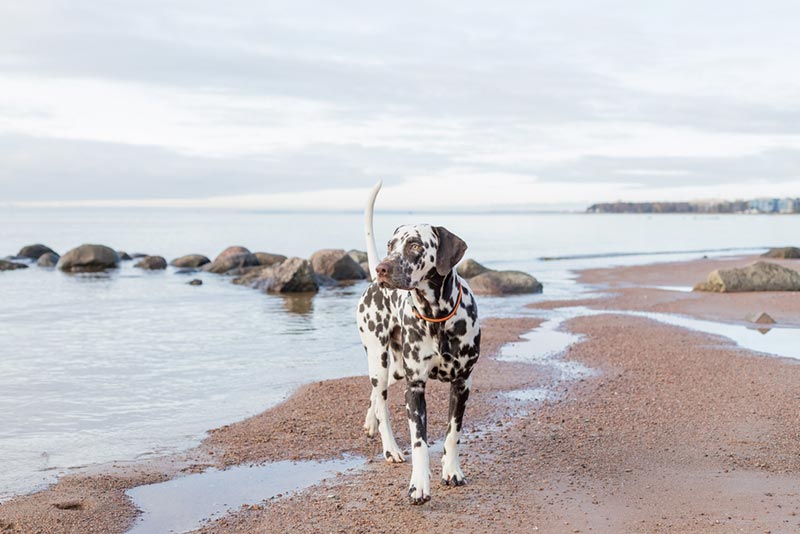
The Dalmatian is a medium-sized dog with a muscular body. Their most distinctive feature is their markings. Dalmatians are often colloquially called “paws.” This breed originated in the Mediterranean region.
The Dalmatian was initially used for herding livestock and guarding vehicles like stagecoaches and fire trucks. They were also used for hunting game such as rabbits and hares. The breed’s signature markings were likely used as camouflage when the dogs were hunting and running through fields. Today, Dalmatians are mainly kept as family pets.
Personality / Character
Dalmatians are energetic and playful dogs. They’re known for being extremely good with children and are often recommended for families with children. Dalmatians are friendly, gentle dogs that thrive on attention and affection.
They are also intelligent dogs, which make them ideal for dog sports like agility or hunting. Because they are strong and energetic, Dalmatians may not be ideal for homes with elderly people or those living in apartments or other small living spaces. Dalmatians have moderate exercise needs, although they do like to have daily walks.
Training
Dalmatians are intelligent and respond well to positive reinforcement training methods. It’s essential to be consistent and firm in your training and be sure to give plenty of praise. Dalmatians are known to have a bit of a stubborn streak and may need extra attention when it comes to potty training. Overall, these dogs tend to take well to obedience training and fancy tricks.
Grooming & Maintenance
Grooming a Dalmatian is not overly time-consuming, as they are a single-coated breed. Brushing their short coat once a week will prevent excess fur and lessen shedding. Owners should also keep an eye out for signs of fleas and ticks, which can be removed with a flea comb and kept at bay with collars and treatments.
Dalmatians have medium-length ears, which should be cleaned once a week. Additional routine grooming, including nail trimming and teeth brushing, is also recommended every few weeks.

Health
Dalmatians, on average, tend to live a bit longer than Great Dane. But just as with any breed, they can be prone to certain health issues. Some of the most common minor health issues that Dalmatians may face include eye problems and urinary tract infections. Fortunately, there are ways to help reduce the risk of these conditions, such as proper diet and exercise and regular vet care.
Bladder Stones
Dalmatians are prone to urinary issues, specifically bladder stones. A specific type of bladder stones is common in Dalmatians, also known as a “urate” stone. These stones can block the urinary tract and can cause serious health problems. Owners may notice signs such as difficulty urinating, excessive drooling, or incontinence. Vets can treat this issue with medication and surgery.
Deafness
Dalmatians are also known for developing or having hearing issues and suffering from hearing loss in old age. In fact, about 30% of them lose their hearing due to this genetic predisposition. They may lose hearing in one or both of their ears as adults.
Common signs of hearing issues include difficulty waking, lack of response to commands or other noises, and a lack of response to squeaky toys. Owners may also notice that their dogs bark more. Though hearing aids are available for dogs, they’re rarely used. Veterinarians typically recommend adjusting to your dog’s condition through training.

Heart Disease
Dilated cardiomyopathy (or DCM) is a serious condition in which the heart becomes too large, thin, and too weak to pump blood efficiently to the body. This can lead to death for Dalmatians and symptoms include weakness or fatigue, coughing, breathing difficulties, and even fainting. To detect abnormal heart rhythms, annual echocardiograms may be done. Treatment typically includes medication and diet supplementation.
Copper-Associated Liver Disease
Dalmatians can also suffer from liver disease. In Copper-Associated Liver Disease, copper builds up in the liver of the dog, causing lethargy, jaundice skin or eyes, and loss of appetite in some cases. Treatment typically includes a low-copper diet and medication.
Joint Disease
If Dalmatian puppies grow too fast, their cartilage may not connect to the bone properly, leading them to develop issues later on. This condition is called Osteochondritis Dissecans (or OCD).
For this reason, vets recommend refraining from overfeeding your Dalmatian and never giving it calcium supplements unless advised to do so. Joint disease can become worse with age and common signs include limping, inability to jump or sit, and pain when sitting.
Suitable for: small or large homes with small or big families. Best for owners who prefer a lot of activity.
Great Dane Overview
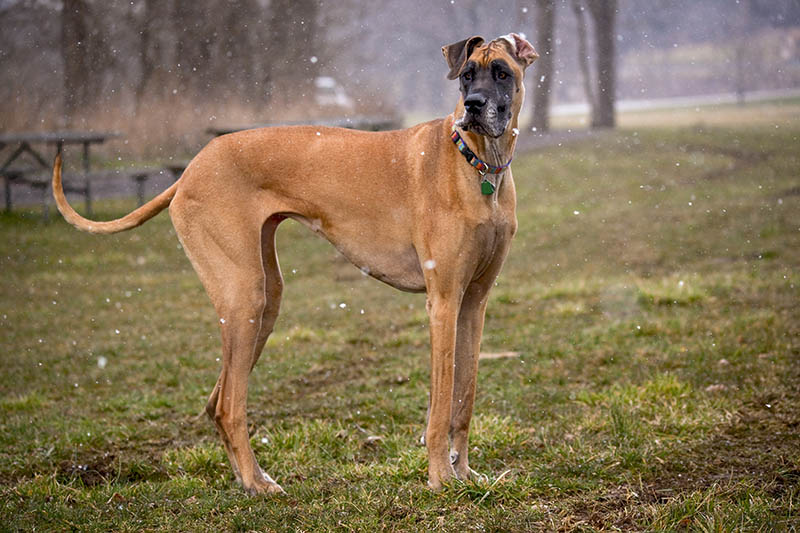
The first thing that really stands out about the Great Dane is its size. Great Danes are actually the tallest domestic dog breed. On average, they stand between 28 and 35 inches at the shoulder, and some dogs have been recorded as tall as 42 inches. They have a long and deep chest, a narrow waist, and a solid muscular frame, making them great as guard dogs.
The Great Dane traces its ancestry back to the German hunting dog, which was used to hunt wild boar. They were bred to be much larger than the average domestic dog, so they could tackle large wild boars and hold them down until their human hunters could arrive and finish the kill. Once hunting with dogs was outlawed, these large dogs became beloved as family pets.
Personality / Character
Great Danes are known to be gentle and loving. While being large dogs, they typically don’t carry themselves in a threatening or aggressive way, unless trained as guard dogs. Overall, they’re energetic dogs that make for excellent family pets and love children.
These dogs are, however, protective and affectionate with their families and make great guard dogs, provided they are socialized from a young age and are used to being around other animals and people. They are intelligent and learn quickly but have a natural instinct to hunt. So, like many other breeds, it’s important to socialize them with birds, squirrels, and other small common wildlife from a young age to help them learn to hunt what they can and leave what they cannot.
Training
Despite their intimidating size, Great Danes are incredibly intelligent, loyal, and eager to please their owners – and it’s recommended that they be trained. With patience and consistency, these gentle giants can be trained to do almost anything. You can start from the basics like sit, stay, and come, and then move on to more complex commands like fetch, roll over, and shake.
It’s best to start training young, and these pups can usually start as early as 8 weeks. Training them young will prevent them from becoming stubborn when they get older – something that can make these large dogs hard to live with.
Grooming & Maintenance
Great Danes are generally low maintenance when it comes to grooming. Because of their short single coat, they do not generally need to be bathed as often as long-haired or double-coated breeds. But if they’re kept as outside dogs, they may require baths more often – or you may find that these large dogs will quickly stink up your entire house.
Weekly coat brushing in addition to other routine care such as teeth brushing, nail trimming, and ear cleaning, will help keep them free from common canine issues. And like Dalmatians, they also have floppy semi-long ears that should be cleaned weekly to avoid bacteria buildup and infection.
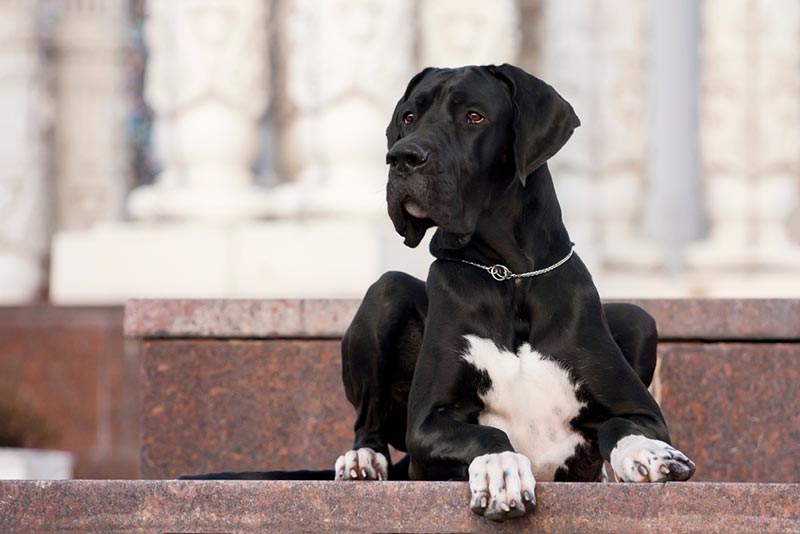
Health
Great Danes are sweet dogs that have a loving nature. They also have a relatively short life expectancy and may require more money to keep healthy, given their large size. One way to do this is through a healthy diet, plenty of exercise, and regular vet checkups. Here are a few common health conditions associated with this breed.
Dilated Cardiomyopathy
This is a common heart disease in larger breeds like the Great Dane. It can occur when the dog’s heart becomes weaker and eventually enlarges to a point where it becomes overworked. It’s a genetic condition, but no one can pinpoint the exact cause so it can’t be stopped from happening.
An echocardiogram can confirm the condition. Common signs include difficulty standing or coughing, in which case your vet should be contacted. Medication can help this disease, but it’s irreversible.
Gastric Torsion (aka Gastric Dilatation Volvulus)
Gastric Torsion (aka bloat) is another issue common in this breed, as a result of their deep chests. It occurs when the dog’s stomach fills up with gas, fluids, or a mix of both – and more than it normally would.
Signs of this disease include vomiting, excessive drool, pacing, and dry heaving. GDV can be surgically treated once it occurs, but it must be done quickly – it can prove fatal if it isn’t treated. Owners can actually prevent them from getting it when they’re young by having them spayed or neutered.
Hip Dysplasia
Great Danes, like many large and massive breeds, will likely face this skeletal issue in their lives. Hip dysplasia is a condition where the hip socket does not form properly. It causes the dog’s leg bone to pop in and out of its hip socket every time it sits or walks.
The condition can be exacerbated by excessive growth or obesity. Too much food, particularly too much protein and calcium at once, can lead to joint problems. The only treatment options are surgery or long-term pain management, so early detection is helpful. Your vet should be consulted if you notice any stiffness, difficulty jumping, limping, or other signs of pain or discomfort in your Great Dane.
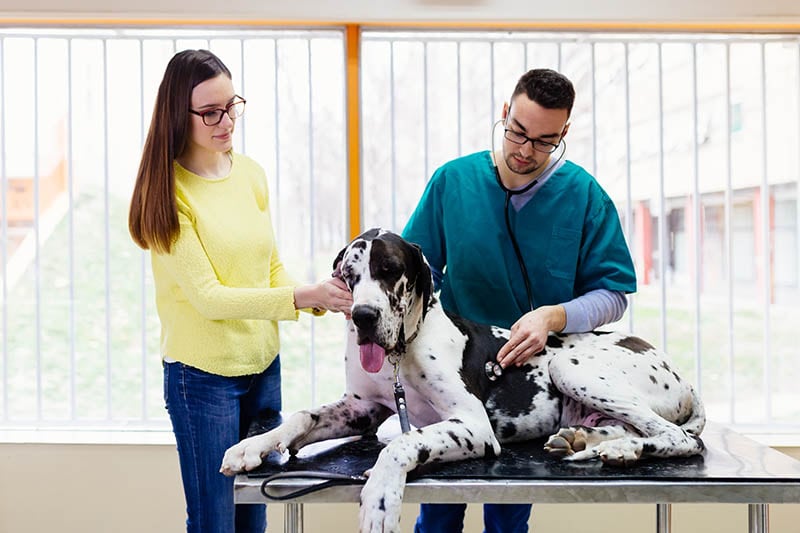
Wobbler Syndrome (aka Cervical Spondylomyopathy)
This genetic problem can also affect large and massive dog breeds that have long necks. It’s caused by their bones not being properly formed and pinching nerves in the spine. The pressure causes nerve function problems in their back or front legs or both. This can cause them to have a wobbly, unsteady gait. For this issue, surgery or a permanent neck brace may be necessary to help.
Hypothyroidism
Thyroid problems, specifically hypothyroidism, can sometimes occur in Great Danes. It’s not as common as other issues, but it should be noted as it can lead to sudden changes in their appearance.
With hypothyroidism, the body may not produce enough thyroid hormone, which can lead to hair loss, dry skin, and aggressive or noticeable changes in behavior. A blood test can detect the disease, and it is easily treated with medication.
Suitable for: Large homes or spaces with a lot of room. Best for owners who don’t mind a lot of activity and can take care of a large canine (i.e., grooming, food, daily exercise requirements, etc.)
Which Breed Is Right for You?
Dalmatians are a bit smaller than Great Danes but are just as energetic and will require around the same level of grooming and daily exercise. They, too, make great companions for families with children, though they should be monitored closely around young children.
They’re also easy to train and do well in most living situations. But if you’re looking for a more intimidating guard dog, the Great Dane may be a better fit. If you want a friendly dog that’s a bit on the smaller side, perhaps the Dalmatian will be the better choice.
See also: Male vs Female Great Dane: How Do They Compare? (With Pictures)
Featured Image Credit: Left – RebeccasPictures, Pixabay | Right – Tara Lynn and Co, Shutterstock

 Dalmatian Overview
Dalmatian Overview